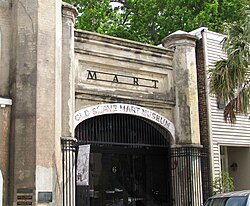Old Slave Mart
|
Old Slave Mart
|
|

Old Slave Mart facade
|
|
| Location | 6 Chalmers Street, Charleston, South Carolina |
|---|---|
| Coordinates | 32°46′38″N 79°55′48″W / 32.77722°N 79.93000°WCoordinates: 32°46′38″N 79°55′48″W / 32.77722°N 79.93000°W |
| Area | less than one acre |
| Built | 1859 |
| Architectural style | Gothic Revival, Romanesque |
| NRHP Reference # | 75001694 |
| Added to NRHP | May 2, 1975 |
The Old Slave Mart is a building located at 6 Chalmers Street in Charleston, South Carolina that once housed an antebellum slave auction gallery. Constructed in 1859, the building is believed to be the last extant slave auction facility in South Carolina. In 1975, the Old Slave Mart was added to the National Register of Historic Places for its role in Charleston's African-American history. Today, the building houses the Old Slave Mart Museum.
The Old Slave Mart was originally part of a slave market known as Ryan's Mart, which covered a large enclosed lot between Chalmers and Queen streets. The market was established in 1856 by Charleston City Councilman Thomas Ryan, after a citywide ban on public slave auctions made private facilities necessary. Slave auctions were held at the site until approximately 1863; in 1865, the Union Army occupied Charleston and closed Ryan's Mart. The Old Slave Mart Museum has operated on and off since 1938.
The Old Slave Mart is a 67-foot (20 m) by 19-foot (5.8 m) brick structure with a stuccoed façade. The front (south side) faces the cobblestone-paved Chalmers Street. The building originally measured 44 feet (13 m) by 20 feet (6.1 m), but an extension in 1922 gave it its current dimensions. The unique façade of the Old Slave Mart consists of 20-foot (6.1 m) octagonal pillars at each end, with a central elliptical arch comprising the entrance.
The building originally contained one large room with a 20-foot (6.1 m) ceiling. In 1878, a second floor was added, and the roof was overhauled. The arched entryway originally held an iron gate; in the late 1870s it was filled in with simple doors. Interior partitions were added in subsequent decades, dividing the first floor into three rooms. Today, there is an iron gate in the archway once again.
Throughout the first half of the 19th century, slaves brought into Charleston were sold at public auctions held on the north side of the Exchange and Provost building. After the city prohibited public slave auctions in 1856, enclosed slave markets sprang up along Chalmers, State, and Queen streets. One such market was Ryan's Mart, established by City Councilman and broker, Thomas Ryan and his business partner, James Marsh. Ryan's Mart originally consisted of a closed lot with three structures— a four-story barracoon or slave jail, a kitchen, and a morgue or "dead house."
...
Wikipedia
